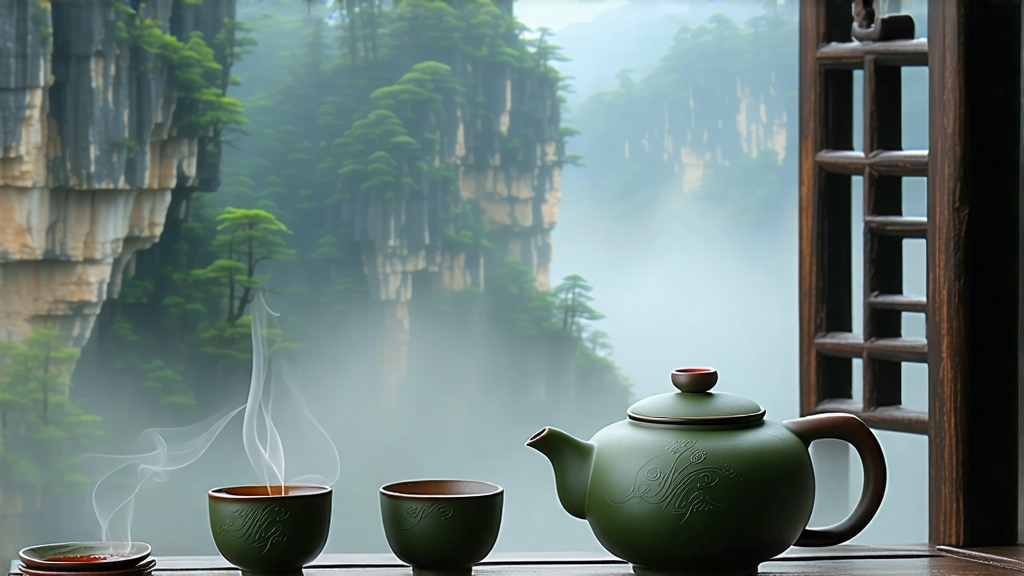
High above the winding Jiuqu Stream, where the vertical cliffs of the Wuyi Range catch the first light of Fujian’s dawn, grows the most myth-shrouded member of the oolong family—Da Hong Pao, literally “Big Red Robe.” To Chinese tea lovers those three syllables evoke more than flavor; they summon poetry, imperial intrigue, and the taste of stone itself. For international drinkers still mapping the vast universe of oolong, Da Hong Pao is the perfect gateway, because in one leaf it compresses thirteen centuries of tea history, three stages of craft that flirt with the edge of ruin, and a finish that reminds tasters of drinking liquid minerals while standing in a pine forest after rain.
Historical whispers place the birth of Da Hong Pao during the late Ming dynasty, when a scholarly monk, grateful for the healing power of wild tea growing from Wuyi’s crevices, wrapped the bushes in his own vermillion robe as winter protection. Whether legend or marketing, the image stuck: crimson silk against charcoal rock, a robe of gratitude draped over living tea. By the early Qing the Kangxi Emperor was reportedly sending riders north with compressed cakes of this “rock tea” (yancha) to ease his mother’s ailing stomach. The court’s favor turned a local monastic beverage into tribute tea, and imperial demand carved the first narrow paths along the cliff faces so tea pickers could reach the mother trees that still survive today—six ancient bushes clinging to a fissure known as Nine-Dragon Nest. In 2006 the Chinese government declared those originals off-limits for commercial harvest; a single 350-gram lot picked in 2005 later auctioned for almost 30,000 USD, making Da Hong Pao the most expensive tea per gram ever sold. Fortunately, centuries of grafting have spread its genetic song across the Wuyi micro-region, so modern drinkers can taste authentic “rock rhyme” without auction paddles or palace connections.
Geology is the first ingredient. The Wuyi Shan are volcanic tuff and granite forced upward then eroded into a maze of gorges; daytime heat gets stored in the rock and released at night, creating a 10 °C diurnal swing that forces slow, compound-rich growth. Pines and camphor trees weave their roots among the tea bushes, sharing mycorrhizal fungi that deepen leaf complexity. Locals summarize this terroir with the untranslatable word yan yun—“rock rhyme.” A proper Da Hong Pao should echo the cliff: a front note of orchid, a mid-palate of roasted stone fruit, and a lingering finish like rain on slate. If you detect only charcoal, the roaster has shouted down the mountain; if you taste only flowers, the leaf has not conversed with the rock long enough.
Although six mother trees exist, the market recognizes three broad categories of Da Hong Pao. The first, Pure Mother Tree, is now illegal to harvest and exists mainly in private collections and state vaults—more cultural relic than beverage. The second, Graft-Descendant or “Qi Dan,” is propagated from cuttings of the originals and grown in the same 60-square-kilometer core scenic zone; these bushes yield the tea most connoisseurs mean when they speak of authentic Wuyi Da Hong Pao. Finally, blended “Commodity DHP” combines selected yancha cultivars—often Rou Gui for spice, Shui Xian for body, and Bei Dou for aroma—to approximate the mother tree profile at accessible prices. Skillful blending is an honorable craft in Wuyi, akin to Champagne houses balancing Pinot and Chardonnay, and a well-executed blend can outperform a careless single-bush tea.
Turning leaf into rock-rhyme is a six-act drama that stretches across four seasons. In late April, pickers climb bamboo ladders tied to the cliff face, plucking only the middle three leaves of each shoot when the morning sun has burned off dew but before the gorge heat wilts turgor. The first act, sun-withering, spreads the leaf on bamboo racks set into natural depressions where reflected cliff light warms but does not scorch. Act two, indoor withering, alternates between shaking and resting every hour for the better part of a night; the leaf edges bruise against wicker trays, initiating oxidation at a rate precisely dictated by humidity read from pine-cone scales—an indigenous barometer Wuyi farmers